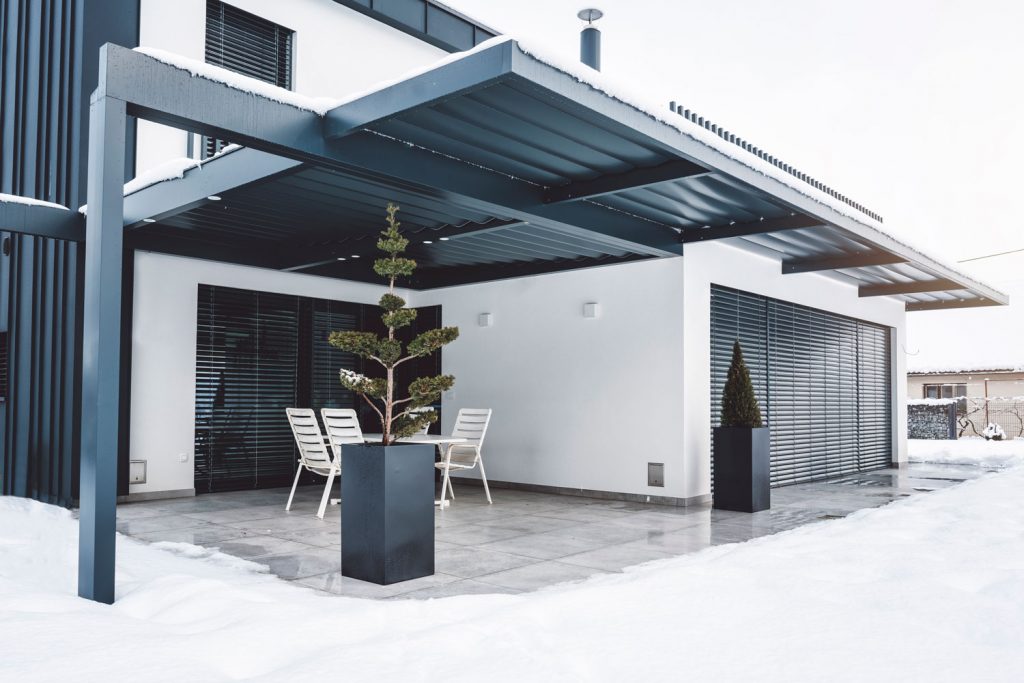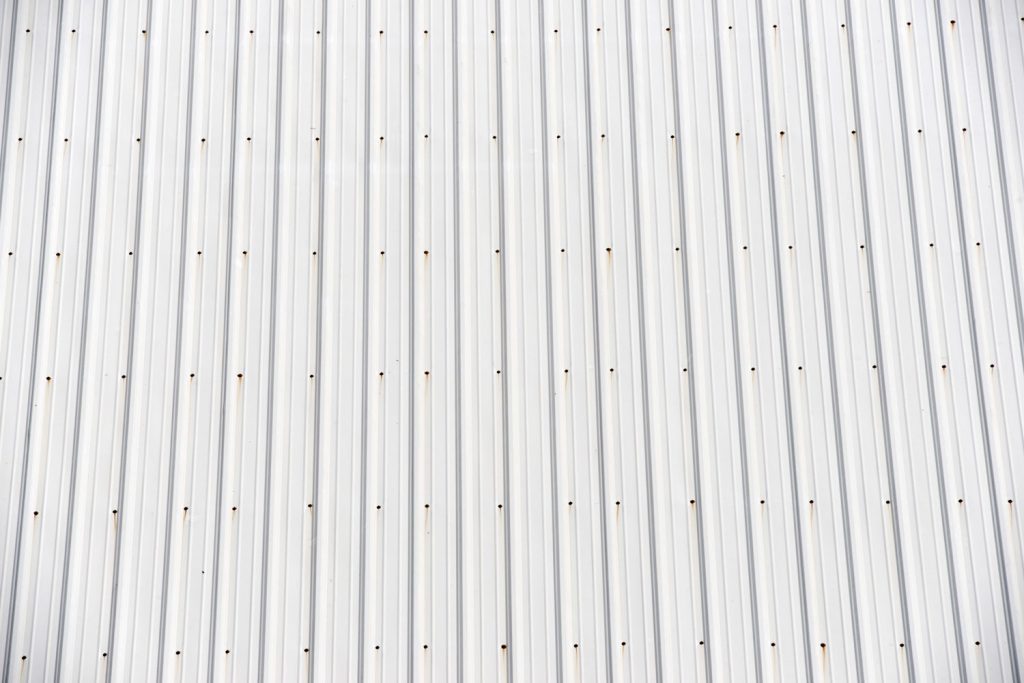Insulating a patio roof can enhance the protection provided by the shade. By now you may be wondering about the steps to insulate an aluminum patio roof. We have you covered, as we consulted with the experts to bring you the answer.
Insulating an aluminum patio roof requires certain key items, such as an aluminum roof cleaner, roofing cement, and fiberglass batts. Once the equipment and materials are acquired, follow these basic steps:
- Remove loose dirt and debris from the roof using an appropriate cleaning solution.
- Patch the cracks and gaps in the roof.
- Attach the fiberglass batts.
- Place and secure the foam insulation and its edges.
- Finish the project by applying a coat of paint.
It's important to follow these steps precisely to avoid making costly mistakes. If you still have more questions about the process, don't worry. In this post, we'll discuss the topic in more detail. Without further ado, let's get into it.
![A luxurious modern patio with aluminum roofing, How To Insulate An Aluminum Patio Roof [A Complete Guide]](https://hvacseer.com/wp-content/uploads/2021/10/How-To-Insulate-An-Aluminum-Patio-Roof-A-Complete-Guide-683x1024.png)
Steps To Insulate An Aluminum Patio Roof
Gather the items and follow the guide below to help you insulate your aluminum patio roof properly:
What You’ll Need
- Roofing cement or sheet metal
- Fiberglass batts
- Rigid foam insulation
- Spray foam insulation kit
- Aluminum roof cleaner
- Putty knife
- Plaster
- Paint
- Drill
Step-By-Step Guide
- Start by scrubbing the roof’s inner side with a light acid solution to remove loose debris. You may also use a mixture of a tablespoon of chlorine bleach mixed with a gallon of water. Otherwise, a commercially made aluminum roof cleaner should also work well.
- Use sheet metal to patch cracks and gaps in the roof. Do this step by pressing the patio roof’s shingles down after applying caulk. Another option is to use roofing cement and fill these imperfections with a putty knife.
- Once the patches dry, attach the fiberglass batts by connecting them onto the patio roof with duct tape or insulation adhesive. It’s important to create a ½- or ¾-inch allowance in between the roof and the batts. Doing so will reduce the risks of reducing the insulation capacity.
- Install the foam insulation. Make sure to place each piece adjacent to each other and perpendicular to the roof's foundation. Also, make sure to cut the insulation according to the patio roof's size.
- Hold the insulation in place with galvanized steel nails or staples. This material is highly resistant to rust and weather damage. Using other nails or staples other than galvanized steel might not have the same or similar ruggedness.
- Use duct tape to secure the foam insulation’s edges. If you see gaps between the insulation and the roofing’s foundation, you can fill them with plaster or light mortar. Also, you can use spray foam insulation if you missed some hard-to-reach areas on your patio roof.
- Finish the insulation by adding a coat of either acrylic or latex paint on it.
You can also watch the video below for more:
At this point, you might be thinking about insulating your porch’s ceiling. If so, read this post for more information: Should You Insulate A Porch Ceiling? [And How To]
Click here to see this fiberglass chopped strand mat cloth on Amazon.
Do Aluminum Patio Covers Get Hot?
Aluminum, in itself, can get hot. However, it’s a thin material with excellent thermal conducting and heat dispersing properties. Therefore, an aluminum patio roof can cool fairly fast, providing sufficiently cool and comfortable temperatures in its provided shade.
Do You Need A Vapor Barrier Under A Metal Roof?

Installing a vapor barrier under a metal roof is ideal to prevent condensation and moisture buildup.
Otherwise, the metal roofing can gather excess dampness. Moreover, the moisture in a metal roof will often require extended periods to evaporate, leading to great risks of mold and corrosion.
It’s also important to install a 3D mesh with the vapor barrier. That way, the barrier won’t absorb a significant amount of moisture, extending its lifespan. For more information about preventing condensation on metal roofs, check out the video below:
Click here to see this product on Amazon.
How Do You Stop Condensation On A Metal Roof?
Insulating a metal roof can help prevent condensation and its related issues. One option is to cover the roofing with fiberglass insulation with a vinyl backing. In turn, you can prevent humid air from reaching the metal roof.
Certain scenarios may also allow waterproof insulation on roofs. Using expanded polystyrene (XPS), extruded polystyrene (EPS), or polyisocyanurate are ideal choices. Here's a quick look at these different waterproof insulation options in better detail:
- XPS: Made with polystyrene pellets, along with other chemicals, and treated until liquefied. The resulting product is a durable, thick, and waterproof substance with heat-dispersing capabilities.
- EPS: Ideal for insulating a range of items from coffee cups to concrete walls. EPS has similarly strong waterproofing traits when compared with XPS. However, this substance usually absorbs more water than the other waterproof options, leading to a shorter-than-average lifespan.
- Polyisocyanurate: Also called polyiso, this material looks like a sturdy foam board commonly used to absorb and disperse heat in ceilings and walls. It can also remain stable to as low as -100 degrees Fahrenheit and as high as 250 degrees Fahrenheit.
Search for the R-value on the different insulation options available.
This measurement tells users about the temperature resisting abilities of insulating material. Generally, a higher R-value score provides better climate control and energy efficiency to homes than lower-valued models.
Click here to see this Wrap-On 16509 pipe wrap on Amazon.
What Color Metal Roof Is The Coolest?

Stone White is the coolest color for a metal roof. Take note that light-colored metal roofing generally disperses heat better than darker colors.
For example, a metal roof colored with a Kynar 500-based resin paint can be cooler by about 50 to 60 degrees when compared to a patio roof with dark asphalt shingles.
It’s because white can reflect all visible light wavelengths. On the other hand, black absorbs all visible light wavelengths, making dark objects hotter than light-colored things.
If the Stone White color isn’t available, other options to help resist and disperse heat for metal roofs include beige, light green, light bronze, and peach.
It’s also worth mentioning that coating a metal paint with a reasonably light color may reduce energy expenses by up to 30%.
Click here to see this product on Amazon.
How Much Does An Insulated Patio Roof Cost?
Standard prices for insulated patio roofs generally cost around $14 to $18 per square foot. The final costs can differ per project depending on the unique engineering requirements.
However, the overall price range to install an insulated patio cover is $6,000 to $8,000 with 20 x 20 feet measurements.
If a patio roof exists, and you want to add insulation, the prices of foam insulated panels can range from about $7 to $14 per square foot. The fees can increase by an extra $1 per square foot if you use professional services for the installation.
It’s also important to note that the expenses for expert help can increase if you opt to install high R-value insulation boards.
Is An Insulated Patio Roof Worth It?

Adding an insulated outdoor space, such as a patio roof, is generally a great idea. In turn, this addition to the property can help increase the return on investment for home sellers.
The 2014 Cost vs. Value Report for Phoenix, AZ, mentions that adding a patio or deck with a composite material construction can deliver 69.1% returns.
Additionally, Brian McHugh, Owner of Colorado-based construction company McHugh Construction, says that adding a patio can provide lot sellers with an 80% return. In turn, adding a patio with an insulated roof can increase those returns further than usual.
Final Thoughts
Cleaning an aluminum patio roof is the first step to insulating it. Upon installing the insulation batts, make sure to secure them with duct tape and nails. You may also fill gaps with spray foam insulation. Apply a fresh coat of paint to finish the project.
Another option is to install a vapor barrier on your aluminum patio roof. Waterproof insulation options are also available for homeowners who want to take advantage of better moisture-resisting characteristics.
But adding these products, regardless of the choice, can help prevent unwanted condensation and moisture buildup, which would otherwise cause issues like corrosion and mold growth.
You can also read the following posts for some related content on insulation:




